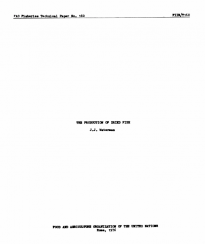Application of Appropriate Technology for Artisanal Product Storage
Good storage involves controlling temperature, humidity, light, pests and hygiene. As well as good storage design, the following is an overview of controls that can be put in place to address the main causes of food loss and waste (FLW).
Control of Physical Damage/Breakage
Control of Physical Damage/Breakage
As well as careful handling of rigid containers, boxes or baskets with frames can be used as protective packaging to prevent physical damage. Any rigid packaging must be strong enough to allow stacking without the packaging collapsing or compressing the products. Packaging must not break due to normal handling and must be strong enough to withstand transport. Packaging should not make carrying difficult and should contain up to 15kg of product.
Control of Moulds
Control of Moulds
If artisanal fish products have not been fully dried and are left in storage for too long, moulds will inevitably grow on exposed surfaces. The obvious way of preventing mould is to dry the product fully in the first place. However, this can be complicated by several factors: it can be difficult to judge when a product is dry (e.g. a product may be dry on the surface but damp inside); there is a tendency not to dry product too much if the end product is to be sold by weight; and high humidity can result in the uptake of moisture by a product during storage.
Moulds can be removed with water and products re-dried or re-smoked. However, a long-term solution is to use storage facilities which are well designed with good ventilation and which are protected from rain and groundwater. During rainy seasons it will be important to inspect the stored products every few days. Fish with high mold growth must be discarded because of the risk of mycotoxins.
Good packaging can prevent mould attack by keeping the fish dry. Fish products can be packed in cardboard boxes which are covered with polythene to prevent the ingress of moisture. Plastic is preferred over other the materials as it is water proof. However, if plastic is to be used as packaging, the fish product must be properly dried and not damp.
Control of Insect Infestation
Control of Insect Infestation
Fish is susceptible to beetle infestation once the moisture content is lowered. Therefore, artisanal fish products are subject to beetle infestation throughout storage and transportation and the potential for FLW is great. There are several approaches to controlling FLW caused by insect (beetle) infestation:
Screening and barriers
- If appropriate containers or packaging are used for the transportation and storage of fish products then these alone will be sufficient to prevent insect infestation. Dried fish have been stored for up to one year in sealed polythene bags without serious loss of quality. However, the product must be free from insects prior to storage.
Insecticides
- Only the following compounds have maximum residue levels (MRLs) established for use on cured fish:
- Pirimiphos-methyl (MRL 10mg/kg)
- Pyrethrins synergised with piperonyl butoxide
- Until safety approval has been gained, non-approved chemicals must not be used for application on cured fish, no matter how effective their insecticidal action.
Plant and plant materials
- There is evidence of several plants and plant materials being used to control beetle infestation of dried and smoked fish. These include neem (Azadirachta indica), citrus peel, oils, peppers and leaves of Boscia senegalensis.
Salt
- Salt affects the water and electrolyte balance of insects, disrupting their biological functions. Although evidence is contradictory, muscle tissue levels of above 10% salt will prevent FLW due to Dermestes maculatus, but to control other species of insect, higher salt concentrations maybe required. Salt would be applied to the fish during processing, typically before sun drying or smoking.
Heat
- Subjecting insects to excessive heat will kill them. For example, heating dried fish to between 50°C to 60°C will kill all life stages of Dermestes maculatus. Regular smoking of smoked fish can also control beetle infestation.
Other methods
- Other methods of controlling beetle infestation of artisanal fish products which have been mentioned in literature include fumigation, inert dusts, ionizing radiation, pheromones and insect growth regulators.
Control of Other Pests
Control of Other Pests
Damage from animal pests, such as rodents, can be controlled by careful design of the building used for storage. Simple precautions include avoiding large gaps in the construction through which animals may enter. Ventilation openings must be screened against birds. Careful choice of packing materials can also afford some protection for fish during storage (e.g. plastic or metal sheet boxes). Implementing a proper pest management system is also advisable.
Control of Oxidation
Control of Oxidation
Rancidity due to oxidation will affect fatty fish more than lean fish. Oxidation requires contact with air, so packaging which provides an air tight barrier will help reduce oxidation. Salt is known to accelerate oxidation. Antioxidants and chelators are used on food products to prevent oxidation.
Key Publications
Small Scale Processing of Fish Types of fish species, fish products, processing technologies, processing methods, and suggestions for avoiding spoilage before, during and after processing, are discussed. This publication gives particular regard to small-scale producers in developing countries. |
| |
Detailed description of dried fish production and storage. | ||
A Post-harvest Handling of Low-Value Fish Products and Threats to Nutritional Quality Included is a review of the processing and storage of low-value fish products in Lake Victoria, including the impact on nutritional quality and their contribution to populations at risk for malnutrition, and with HIV/AIDS. |
More Resources
More Resources
31 October 2023
05 September 2023














